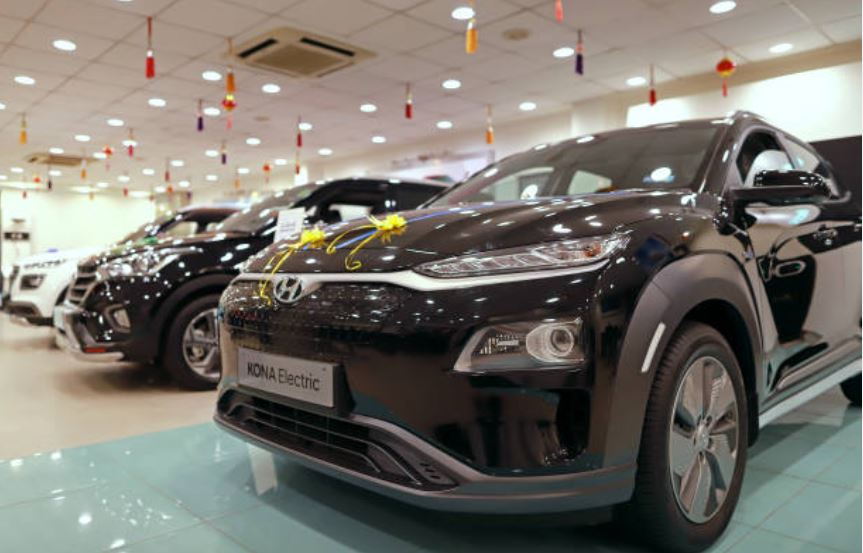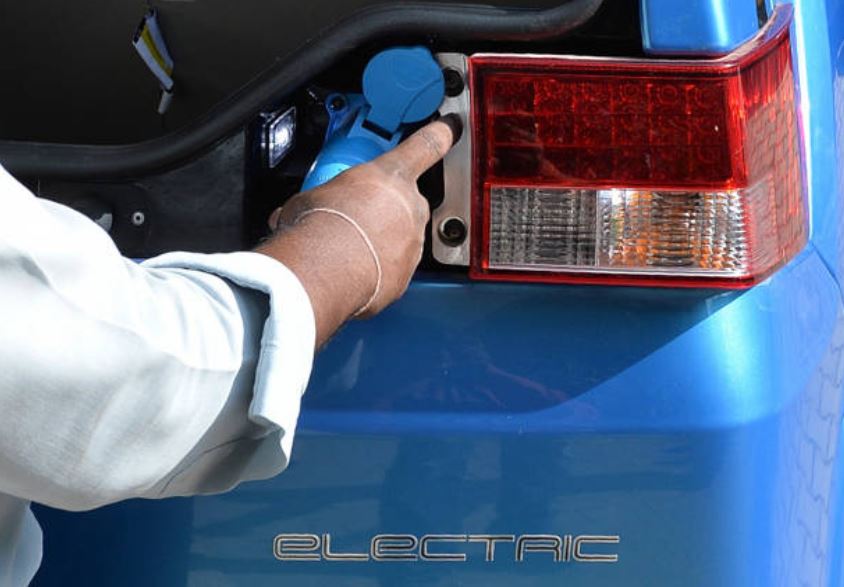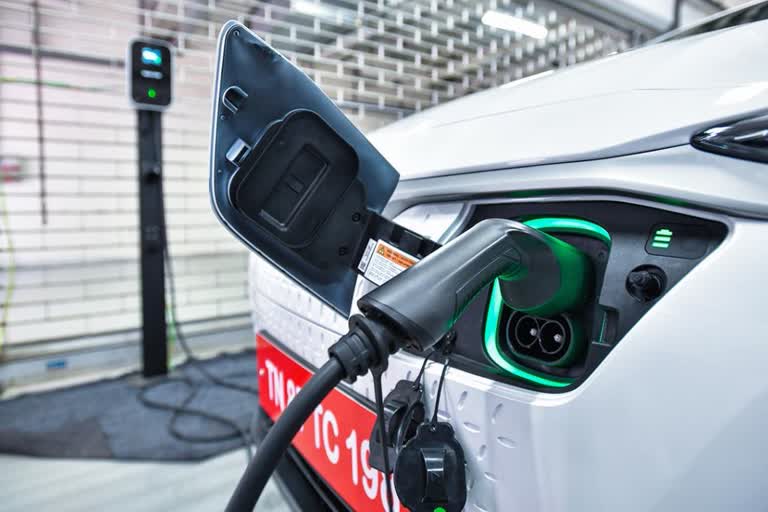Hyderabad: Future India will ride in electric vehicles (EVs) if one goes by the pronouncements of the country’s policymakers. The air will be cleaner. The noise level as well as the oil import bills will be down. And, if everything goes according to the Central government’s reported plan, India will be a manufacturing hub for EVs, just as China is of many industrial products now.
But how near that future seems is an important question. Hyundai Motor Co. launched India’s first electric SUV this summer and a few months later, the automaker finds itself on a lonesome road. In a nation of about 15 crore drivers, only 130 Kona SUVs were sold to dealers through August.
That slow pace is emblematic of the difficulties carmakers face in establishing an electric foothold in the fourth-biggest auto market, even with committed government support.
The Kona sells for about Rs 25 lakhs while the average Indian earns about Rs 1.45 lakhs a year and the best-selling Maruti Alto costs Rs 2.80 lakhs.

Yet Kona’s sticker price only kicks off the conversation about why EVs aren’t gaining traction in India there’s also a lack of charging infrastructure, a reluctance by banks to finance purchases and an unwillingness among government departments to use EVs as directed.
Barely more than 8,000 EVs were sold locally during the past six years, according to data compiled by Bloomberg. China sells more than that in two days, according to Bloomberg NEF projections.
The affordability of electric cars in India is just not there. The government or the car companies do not expect that in the next two to three years there will be any real buying of electric vehicles. The segment still isn’t making meaningful strides more than four years after the government started promoting cleaner vehicles for one of the world’s most polluted countries.
In February, the Centre committed to spending $1.4 billion on subsidies, infrastructure and publicity.
The potential of India’s EV market can’t be ignored. There are only 27 cars for every 1,000 Indians, compared with 570 for the same number of Germans, allowing global automakers an opportunity to challenge the dominance of Maruti - the unit of Japans Suzuki Motor Corp that sells every other car on local roads.
Maruti is not introducing its first EV until next year. Tata Motors Ltd. and Mahindra & Mahindra build some base-level electric cars, yet they have a limited range or are exclusively for government use.
More than half of the passenger vehicles sold in India last year cost Rs 5.80 lakhs or less. Electric cars won’t achieve price parity with gasoline-powered cars until the early 2030s, experts say. Consumers care about EVs, and the excitement is there, but that stops the moment they know the price.
Read more:US-Iran tensions hit Indian basmati exports
Yet even for those who can afford the Kona, plugging in is problematic. India had an estimated 650 charging stations for cars and SUVs in 2018. China, the largest market for EVs, has about 4,56,000 charging points, official data shows. India’s inadequate charging infrastructure stems from locals chicken-and-egg approach to the issue.

At a conference in New Delhi last month, government officials and EV- component makers debated whether to create an adequate charging infrastructure to promote sales or whether to wait until there are enough EVs on the roads before building it out. We are pretty sure that people are going to like EV, but we would have our challenges like infrastructure.
Those include first requiring that the buyer can install a charger at home. But there’s another factor besides income that makes it difficult to pay for one of these cars. Until there’s an established secondary market for EVs, banks and other institutions are hesitant to extend purchasing loans.
The government, both federal and local, will have to offer help for EVs to be adopted in the mass market. The budget in July included incentives such as reduced taxes, income tax benefits and import duty exemptions for certain EV parts. The first beneficiaries will be the ubiquitous scooters and motorcycles with subsidies meaning to support sales of 1 million two-wheelers, compared with 55,000 electric cars.
Yet the government still needs to practice what it’s preaching. Energy Efficiency Services Ltd., a joint venture of state-run companies responsible for replacing state vehicles with EVs, awarded its first tender in September 2017 for 10,000 cars. But as of July, agencies had accepted only 1,000 of them.
Now EESL is offering vehicles to taxi companies. EV experience across the world is limited. Even in countries where EVs are used, people’s choices and, patterns of vehicle use, as well as the infrastructure available, are different from that in India. Therefore every step on the EV route should be taken with care, for any setback will have serious economic and political consequences.
The automobile industry is already showing signs of a recession across the world. It is claimed that about three lakh persons employed directly or indirectly in the automobile sector have lost their jobs this year in India.
One of the reasons attributed to this is the expected entry of EVs. Electric cars would change the automobile ecosystem drastically. They do not need many of the components, including gears, present in cars using fossil fuels. Naturally, manufacturers would think twice before investing in such components.
It is unclear whether the planners have given serious thought to the implications of the switch from fossil fuels to electricity. Total electrification of the country is yet to be achieved, and even in electrified areas, the quality of power supply is not up to the mark. What will be the annual power requirement if millions of vehicles start running on electricity? And will all the additional power be generated from renewable sources?
There is little sense in reducing carbon emission from vehicles by using electricity generated from polluting sources.
An important and contentious issue that has to be discussed in this context is the revenue side of fuel sale. The Central and State governments’ budgets depend to a large extent on the income from the taxes on petrol and diesel. Will any State be willing to forgo such income in an EV scenario? The annual income of all States put together from fossil fuel sale is above Rs 1.9 lakh crore. The loss of this income can upset the States’ budgets.
At present, the Central government has the power to fix the basic prices of fossil fuels. What will be the situation when the responsibility for last-mile delivery of energy to vehicles falls on the States? There is no guarantee that they will be able to cope with the logistical implications of such a shift.
The first EV that appeared on Indian roads was a compact car. It offered meagre comforts but was priced high. Naturally, public response to the vehicle was not positive. That fear, or suspicion, of the unknown, still remains.
Price and costs of servicing are very important issues from the consumer’s point of view. Electric vehicles do not require servicing or change of parts as frequently as diesel and petrol cars. So how will the manufacturers keep the dealers, who currently earn a substantial part of their income from the servicing of vehicles and the sale of spare parts, happy? And they too, would not like to lose the income from the sale of spare parts. Obviously, they will price EVs high and allow the dealers to take a cut.
The consumer, on the other hand, would be interested in being fully informed about the warranty. Currently, many companies offer eight years’ warranty, but there is a clear possibility of this working to the consumer’s disadvantage. One has to get the EV serviced by the dealer for eight years (unless the warranty policy states otherwise), obviously paying high rates, if one should continue to get the benefits of the warranty.
There have also been cases of electric cars exploding or catching fire for no obvious reasons in Canada and the US. The key components of an EV are the battery and the motor. In order to benefit fully from the EV ecosystem, entire batteries should be made in India. The technology to make highly efficient batteries is available in some industrial countries. It is not advisable to depend on imports of batteries, for all of the producing countries are India’s potential competitors in the EV sector, unlike in the case of crude oil suppliers.
What India needs is advanced technology, either home-made or imported. Charging the battery can pose the most serious difficulty in the daily use of an electric car. Any kind of fast charging is unlikely to make an inter-city ride in India trouble-free. Any difficulty in this regard caused by an EV-related problem will be seen as an attack by the government on mobility, which can invite a backlash.
EVs, as mentioned earlier, is an object of curiosity and will have to wait for quite some time to gain wide acceptance. The right thing to do is to first familiarise Indians with electric two-wheelers, especially scooters, as China did, and then go in for small cars before thinking of bigger vehicles.
All these issues have to be discussed with all stakeholders, including the State governments, representatives of the industry, and public-spirited individuals before a final decision is taken.
(PV Rao, Joint Managing Director, Pennar Industries)




